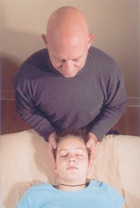Ken Piercy, MTI, CST-D
CranioSacral Therapist

Ken Piercy, MTI, CST-D
CranioSacral Therapist
Using a soft touch generally no greater than 5 grams, or about the weight of a nickel, practitioners release restrictions in the body effecting the craniosacral system to improve the functioning of the central nervous system, optimizing the body's potential physically and intellectually.
Dr. John Upledger, DO, OMM, (the developer of CST) found that a small pressure applied over time can bring about corrective changes to the fascia and membrane systems of the body. The practice facilitates improvement of the overall function of the central nervous system and promotes the body's natural healing mechanisms.
In practice, the technique usually yields results with no negative side effects. Results can be seen in as few as 2-4 sessions, although more involved situations may require additional sessions. Treatment sessions are typically one hour.
Who developed CST?
CST was pioneered and developed by Dr. John E. Upledger, DO, OMM, following extensive scientific studies from 1975 to 1983 at Michigan State University, where he served as a clinical researcher and Professor of Biomechanics. The benefits have been confirmed by research and clinical work over the past 20 years.
Ken Piercy, MTI, CST-D
Upledger Institute Diplomate Certified
CranioSacral Therapist
214-906-2626
13610 Midway Road, Suite 248
Dallas, TX 75244
What is CranioSacral Therapy?
CranioSacral Therapy (CST) is a gentle, hands-on method of evaluating and enhancing the functioning of a physiological body system called the craniosacral system - comprised of the membranes and cerebrospinal fluid that surround and protect the brain and spinal cord. It is often used for the relief of chronic pain such as migraines, neck and back pain and can significantly reduce tension and stress, to name but a few capabilities.

How does it work?
Similar to the cardiovascular system, the CranioSacral system has a flow, rhythm and rate, and can be felt anywhere on the body. This is caused by the production and re-absorption of cerebrospinal fluid resulting in a rise and fall of the fluid pressure.
Built in Texas by Texans

